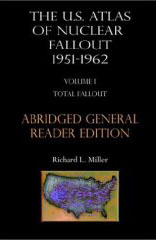|
U.S. Atlas of Nuclear Fallout 1951-1962 Vol 1:
Total Fallout

ISBN: 1-881043-118
The first book in the series was written over a period
of two years from 1998 through 2000 and published in 2000. Based on data from
the National Cancer Institute's 15-year, 100,000-page radioiodine study, the
book preparation involved two years and over 30 Gigabytes of data. When it
was completed in early 2000, the book included over 700 pages of maps and tables
detailing nuclear fallout in the United States from the Nevada Test Site.
The first volume of the U.S. Atlas of Nuclear
Fallout included 11 figures, 137 tables, 135 formulas, 166 2D
maps and 94 3D maps showing where the nuclear fallout landed.
It took 15 years for the NCI to analyze, compile and publish
county-by-county exposure data information regarding radioactive
iodine (Iodine-131) from nuclear fallout. However, radioactive
iodine-131 makes up only two percent of the isotopes in nuclear
fallout. Environmental exposure specialist Richard L. Miller
wondered about the other 98 percent of the radioactive isotopes
in fallout. So, using the NCI data as a starting point, Miller
calculated the TOTAL FALLOUT deposition from every major aboveground
nuclear test for every county in the United States. The book
shows the paths the nuclear clouds took after leaving the Nevada
Test Site, and the more than 10,000 cities, towns and villages
in the path of the clouds. The book also includes lists of each
nuclear test's specific or unusual isotopes. Counties are ranked
by fallout and rainout potential, and a special section shows
which counties received the most Cobalt-60, Cesium-137, Beryllium-7
or Uranium-237. Three-dimensional maps are used to show fallout
and radioisotope levels in specific regions of the country, including
the West, Midwest, South and East Coast. In addition, the top
15 counties are ranked for exposure to 45 different radioisotopes,
from Beryllium-7 through Zirconium-95. In addition, the book
includes a section titled Nuclear Fallout and Cancer. Using three
different statistical techniques, the author evaluates the nationwide
association between nuclear fallout and most of the cancers listed
in the National Cancer Institute's recent Cancer Atlas. A special
section is included that analyzes the association between cancer
and fallout for the 513 Midwestern counties in the states of
Iowa, Illinois, Kansas, Missouri and Nebraska. In this section
are also included tables discussing toxicities and half-lives
of the radionuclides found in fallout. !
There, the reader will learn that many fallout isotopes, such
as Strontium-90 and Americium-241, remain long after the aboveground
nuclear testing ended. If you want to know where you home county
ranks in terms of nuclear fallout, this is the book to read. There
are 10,000 cities, towns and villages listed along with every U.S.
county (even one that no longer exists).
County deposition values are included for Total Fallout as well
as the top 15 US counties for following radioactive fallout components:
beryllium-7, sodium-24, manganese-24, iron-59, cobalt-60, copper-64,
bromine-82, bromine-83, strontium-89, strontium-90, yttrium-90,
yttrium-91, niobium-95, niobium-95m, zirconium-95, molybdenum-99,
technectium-99m, ruthenium-106, silver-109m, palladium-111m,
paladium-112, silver-112, cadmium-115, indium-115m, indium-117,
antimony-126, tellurium-127m, iodine-130, iodine-131, iodine-132,
iodine-133, iodine-135, cesium-137, barium-137, lanthanum-141,
cerium-144, samarium-153, Europium-155, terbium-161, tungsten-181,
tungsten-185, gold-198, gold-199, uranium-237, neptunium-239,
uranium-240, Americium-241 and Curium-242.
The
U.S. Atlas of Nuclear Fallout Vol I : Total Fallout is
still available at Amazon.com. is
still available at Amazon.com.
A
complete list of our technical books on nuclear fallout is
found here.
|
